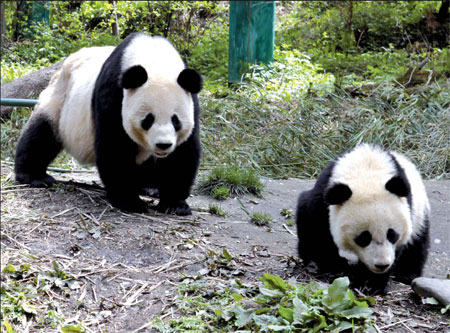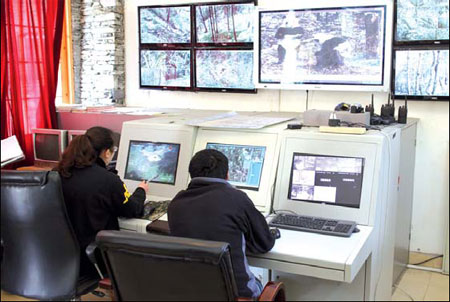Ready to be set free
Updated: 2013-05-10 08:52
(China Daily)
|
|||||||||||
|
Pandas that will move to the new facility have had limited human interaction from birth, so they're better prepared to survive in the wild. Photos by Huo Yan / China Daily |
|
Wolong's staff track pandas' daily activities through monitors to learn how to release them to the wild. Human contact is minmized and staffers wear panda suits when interacting with the animals, as seen on the top screen. |
While the 2008 quake killed multitudes of people in cities, it could help more rare pandas survive in the wild
Wolong
Editor's note: The 2008 temblor shook almost every aspect of life in Sichuan province including that of pandas. In this page, we bring you to their new habitat and see how they are faring.

The 2008 earthquake destroyed Wolong National Nature Reserve, which housed the world's largest panda population. Yet an improved base is being developed 20 kilometers away in what authorities say might be the world's best panda habitat. "We're rebuilding and learning from mistakes made while constructing the first base to enable more pandas to be released," Li Desheng, deputy director of Wolong's administration bureau, says. "This is a more advanced facility. It's a perfect ecosystem in terms of flora and altitude. There's no industry here, so there's no pollution. And there's more space for training and reintroduction."
The new reserve is being built to withstand a magnitude-7 quake and resist one at magnitude-8 - the strength of the Wenchuan quake, the epicenter of which bordered Wolong. The old site was constructed to outlast magnitude-6 tremors.
"You can't predict natural disasters. You might only get one every 1,000 years. But we're prepared," Li told China Daily about two weeks before a magnitude-7 quake struck nearby Ya'an, where more than 80 pandas have been relocated since 2008. None were injured at either site during the recent Ya'an earthquake.

The new base, set for completion in autumn, will have separate roads for tourists and staff, while another highly restricted road will lead to the reintroduction research area. It will host about 70 pandas, 50 of which will live in some form of an enclosure.
Li says the rebuilt reserve will also make it easier to improve biodiversity by ensuring more males - as opposed to just one or two with high libidos - produce offspring. Cubs will live in what officials call the "panda kindergarten".
The biggest obstacle to rebuilding the base remains transport. The dirt road whittled into the mountainside is frequently clotted by landslides and washed out by floods, sometimes for months. Seatbelts are needed when traversing the bone-juddering route to keep passengers from being jostled around like dice in a cup.
Meanwhile, the road leading to Ya'an was destroyed by the temblor on April 20.
"It's long been hard to bring in construction materials and daily supplies," Li says. The new motorway, which will largely be bridges and tunnels, is expected to open around 2015. "It's too dangerous to rebuild the previous route."
Pandas that will live in the new base are spread across the region, with 13 staying at Wolong's old base. About 40 are in Sichuan's Dujiangyan city.
"Most will be relocated to the new Wolong," Li says, adding that about 500 of the 2,500 surrounding residents have been moved to make room for the animals. The cleared areas are being reforested.
"People were happy to move because they realize pandas are important," Li says. "And they know tourism will boom once the park reopens, bringing income opportunities."
Also, moving off the mountains makes residents safer, he adds.
Wolong's administrative bureau chief, Zhang Hemin, says buildings "swayed" and "cracked" but didn't fall in the Ya'an quake. In the 2008 disaster, one panda died and another disappeared.
"The animals have psychologically recovered (after 2008)," Li says. "Some took a month. Some took six."
Wolong's experts have been researching how quakes affect captive and wild pandas.
"This is a rare opportunity to examine this," forest engineer Zhou Shiqiang says. "The results haven't come out yet, but our hypothesis is there will be a vast difference."
Wu Daifu, director of Wolong's reintroduction department, explains: "Pandas have been dealing with disasters, such as quakes, for millions of years. The wild animals seem to have adapted, but the question is how. Captive pandas were deeply affected."

The base's bears were terrified, he recalls. Some climbed trees and did not come down until workers went up after them.
The 2008 quake presented opportunities to study and perhaps save pandas, but disrupted plans to release a second panda into the wild that year. But Wolong's researchers say they have been making progress. They are training five cubs for release and plan to let two go this year and three next year.
The breakthrough has been limiting human interaction from birth, Li says. Contact is minimized and handlers wear panda suits whenever in the creatures' sight.
The first time a panda was released at the reserve - and in the world - was in 2006. However, Xiang Xiang did not survive the winter. He was 2 years old when released and lived only about 10 months.
The second reintroduction, of a bear with less human contact, took place in October. That panda survived the cold.
"There's less food and more competition in the winter," Li says. "We can't be sure the second release will work. But, so far, so good."
(China Daily 05/10/2013 page29)
Today's Top News
List of approved GM food clarified
ID checks for express deliveries in Guangdong
Govt to expand elderly care
University asks freshmen to sign suicide disclaimer
Tibet gears up for new climbing season
Media asked to promote Sino-Indian ties
Shots fired at Washington Navy Yard
Minimum growth rate set at 7%
Hot Topics
Lunar probe , China growth forecasts, Emission rules get tougher, China seen through 'colored lens', International board,
Editor's Picks

|

|

|

|

|

|







